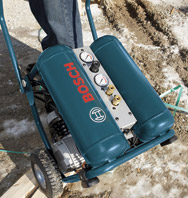 By
Jon Eakes
By
Jon Eakes
Answering the Compressing Questions
Pneumatic tools are core to much of our work today, yet we often don’t have the right mix of equipment or we are not getting the full performance out of what we have. The reality is that we are mixing compressors (the source of power) with hoses (transportation of the power) with nailers or other tools (uses for the power) but often not getting them to all work as an efficient system.
Source of Power
Comparing apples to apples in this field is very difficult — even after the industry invented the Standardized Cubic Feet/Minute that was supposed to simplify things. There is not total agreement on how to measure SCFM, and changes in temperature, humidity and altitude will change the Actual CFM you have to work with anyway. Any of these numbers can help us to size a compressor, but this will still only give you an approximation, and then site experience has to take over.
On the lightest side you can just charge up a small lightweight air tank from your large compressor and carry it throughout the house. Delivery is direct and consumption is low. Along the same lines, in the May 2007 issue of Home Builder, I showed a belt-worn, very efficient CO2 tank for any pneumatic finish nailer called JacPac. You can compress more CO2 into a small tank than air.
Compressor size is determined primarily by tool demand. One rule of thumb is to size the compressor to 1.5 times the demand of your largest power tool, measuring either in CFM, SCFM or ACFM — whatever you can get from the manufacturer’s literature. Shot tools like nailers will sometimes have an “air consumption per cycle” rating that, when divided into CFM, will let you know how many nails per minute the compressor will handle. If you do a lot of rapid fire work, this may be a better calculation than the 1.5 rule.
The fact of the matter is you could have a cumbersome large tank with a small compressor, which would run all the time, or a small tank with a large compressor that would cycle constantly, which is not good for the compressor. The tool would receive the required CFM in both cases, although we usually shoot for a balance between these extremes of tank size and cycling.
Then there is the maximum pressure of the tank storage, anywhere from 100 psi to 200 psi. High-pressure compressors will store more air in a smaller tank, but the wear on the compressor is higher.
Transport of Power
You now know the CFM output of the compressor, and the requirements of the tool, but rest assured there will be losses from one to the other through hoses, couplings, valves and filters. The bigger your line losses, the larger a capacity you need at the compressor. Insure that connectors and couplings do not reduce the free opening. Quick couplings have valves that close when disconnected and slow down air when in use. Four hoses quick-connected together will let less air through than one long hose. Fully open screw-in connectors will give you almost the same flow as a single hose.
A 1/4-inch hose will deliver full pressure to the first nail shot, but may not be able to recharge to full pressure quick enough for the third or fourth quick fired nail. Using a 3/8” hose for most of the run, and then a lighter easier to work with 1/4-inch hose for the last few feet to the tool will make a significant difference in power delivery for rapid shot or continuous flow work because the 3/8-inch hose stores 44 per cent more air. Never put a larger hose after a smaller hose as the pressure drop will be significant. Running multiple tools off of a single compressor requires a manifold.
There are probably more variables in pneumatic systems than any other tool line. For a single framing nailer, delivering at least 2 CFM at 90 psi continuously to the tool end of the hose is usually enough to drive 15 nails a minute. Probably the best mix for a construction site is to have two compressors or “air” sources: one that is very light, portable and has sufficient capacity for the very light trim work we many need to do, and another that is powerful enough for our heaviest demand.





